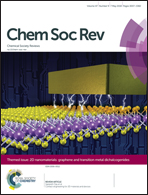Two-dimensional transition metal dichalcogenides: interface and defect engineering
Abstract
Two-dimensional (2D) transition metal dichalcogenides (TMDCs) have been considered as promising candidates for next generation nanoelectronics. Because of their atomically-thin structure and high surface to volume ratio, the interfaces involved in TMDC-based devices play a predominant role in determining the device performance, such as charge injection/collection at the metal/TMDC interface, and charge carrier trapping at the dielectric/TMDC interface. On the other hand, the crystalline structures of TMDCs are enriched by a variety of intrinsic defects, including vacancies, adatoms, grain boundaries, and substitutional impurities. Customized design and engineering of the interfaces and defects provides an effective way to modulate the properties of TMDCs and finally enhance the device performance. Herein, we summarize and highlight recent advances and state-of-the-art investigations on the interface and defect engineering of TMDCs and their corresponding applications in electronic and optoelectronic devices. Various interface engineering approaches for TMDCs are overviewed, including surface charge transfer doping, TMDC/metal contact engineering, and TMDC/dielectric interface engineering. Subsequently, different types of structural defects in TMDCs are introduced. Defect engineering strategies utilized to modulate the optical and electronic properties of TMDCs, as well as the developed high-performance and functional devices are summarized. Finally, we highlight the challenges and opportunities for interface and defect engineering in TMDC materials for electronics and optoelectronics.

- This article is part of the themed collection: 2D nanomaterials: graphene and transition metal dichalcogenides


 Please wait while we load your content...
Please wait while we load your content...